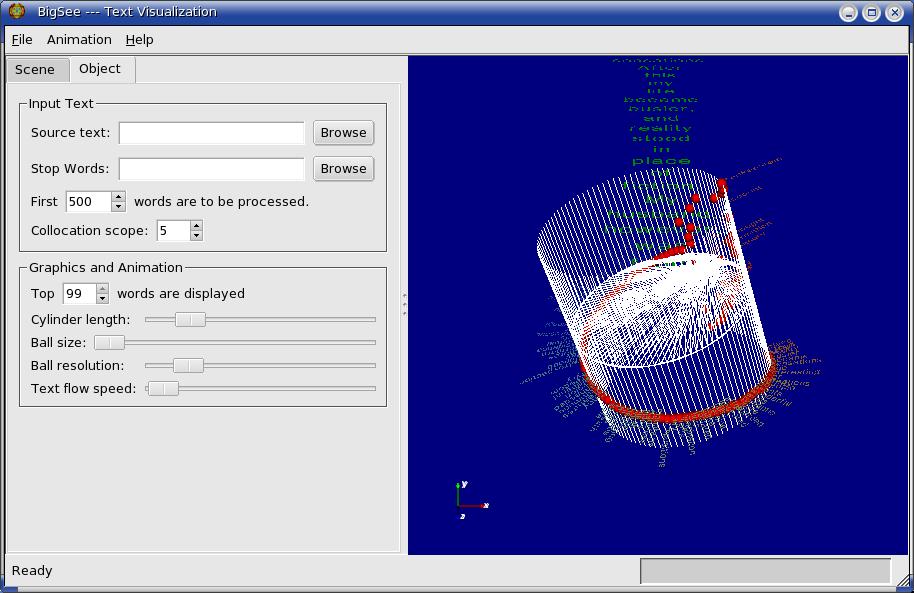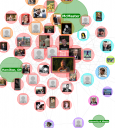 TouchGraph now has a Facebook Plugin that lets you visualize your friends and their location. Its an interesting example of what can be done with visualization of people and relationships.
TouchGraph now has a Facebook Plugin that lets you visualize your friends and their location. Its an interesting example of what can be done with visualization of people and relationships.
Category: Visualization
Journal of Virtual Worlds Research
Stan pointed me to the inaugural issue of the Journal of Virtual Worlds Research which has a number of fine articles.
- “Cityspace, Cyberspace, and the Spatiology of Information” by Michael L. Benedikt is a reprint of a classic paper where he argues that,
If we wish to reach deeply into the “nature†of “space itself†then, I believe we must allow into it, as it were, a substance of some sort: not the æther of nineteenth-century science perhaps, but a registering, tracing, questioning, remembering substance, spread as thinly as we can imagine, but present nonetheless, and definitive of here versus there because of how it pools, how it vibrates, how it scatters difference, différance. (p. 2)
That substance is information. As he puts it later, “ultimately, the space in information and the information in space are one.” (p. 15)
- “Toward a Definition of ‘Virtual Worlds'” by Mark W Bell is a short “Think Piece” defining “virtual worlds” as “A synchronous, persistent network of people, represented as avatars, facilitated by networked computers.” (p. 2)
These two pieces make an interesting contrast since Benedikt focuses on space and Bell manages to define virtual worlds without any reference to space. Benedikt calls for architects to engage in the design of virtual spaces while Bell focuses on the network of avatars – or the people within the space (and persistent time.)
Ever since the Gartner press release saying that “80 Percent of Active Internet Users Will Have A “Second Life” in the Virtual World by the End of 2011″ there has been a renewed interest in virtual worlds. My sense is that the 1990s interest in virtual reality was overblown and ultimately wrong in that people predicted we would be manipulating information inside virtual worlds with VR interfaces, data-gloves, headsets and so on. What has emerged instead is the proliferation of massive multiplayer online environments from games like World of Warcraft to social/creative spaces like Second Life. The headsets and torture apparatus of Lawnmower Man are gone, thank you!
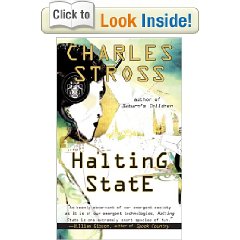 So … what is next? I’ve just finished Halting State by Charles Stross which is a near-future detective story set in Edinburgh where players can move their avatars from game to game in the Zone (something actually proposed by Linden Labs and IBM – see Lohr Free the Avatars – this reference is from the Messinger, Stroulia and Lyons article “A Typology of Virtual Worlds” in the JCWR.) What is more interesting is the way Stross imagines the overlay of virtual and real worlds. Everyone, including cops, wear glasses that provide augmented reality views on the world they walk through, including the ability to see people in their in-game avatar representation while, for example, at a trade fair. Stross does a imaginative job or weaving the virtual into everyday life. (If you like this book you should also read Accelerando – a great accelerating run through the artificial life as it leaves meat behind.)
So … what is next? I’ve just finished Halting State by Charles Stross which is a near-future detective story set in Edinburgh where players can move their avatars from game to game in the Zone (something actually proposed by Linden Labs and IBM – see Lohr Free the Avatars – this reference is from the Messinger, Stroulia and Lyons article “A Typology of Virtual Worlds” in the JCWR.) What is more interesting is the way Stross imagines the overlay of virtual and real worlds. Everyone, including cops, wear glasses that provide augmented reality views on the world they walk through, including the ability to see people in their in-game avatar representation while, for example, at a trade fair. Stross does a imaginative job or weaving the virtual into everyday life. (If you like this book you should also read Accelerando – a great accelerating run through the artificial life as it leaves meat behind.)
A Brief History of Neon — New York Magazine
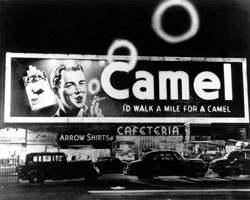
In A Brief History of Neon in New York Magazine I came across reference to Artkraft Strauss one of the first and most important makers of neon signs, ads and marquees. Artkraft Strauss dominated the design of neon signs for Times Square including the new year’s midnight ball-lowering. Artkraft Strauss is still around as a design and consulting company and they have a great archive of images of “100 years of commerce, design and Times Square celebrations”. It is a treasure of neon sign design in New York from the first days.
Newsknitter: Knitted Visualization

Newsknitter is a project that gathers news from RSS feeds and then generates a visualization that can then be knitted into a sweater. Check out the images of sweaters knitted. This project has been exhibited at Ars Electronica and is the work of two PhD candidates at Kunstuniversität Linz. At first the idea of machine knitted sweaters of text visualization sounds like a conceptual art work with no future, but as I think about it, the idea of just-in-time information being visualized and used to generate stable material objects like a sweater sounds timely. All sorts of objects could have their designs generated on the spot and on demand from information off the net. Why should data be only visualized and not materialized?
Wordle: word cloud art
Just found this delightful, simple, slightly addictive text toy called Wordle.
This example is a big chunk of text from Corporate Ipsum, my new favourite dummy text generator.

Found at ouroboros.
RSS Feed Screen Saver

I just noticed that Mac OS X has a RSS feed screensaver that shows headlines in spiraling columns. When you see an item you want to read you press a key and it opens the item. It is an interesting example of live text visualization. You can see it on YouTube – RSS Feed on my Screen saver.
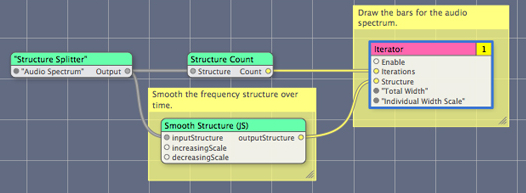
The RSS Screensaver seems to be built in a visual programming language for the Mac called Quartz Composer. From the documentation and discussions online it sounds like something one can play with easily (when I have the time.)
What would an academic screen saver look like?
Interactive Matter
The Interactive Matter group that I and Lynn Hughes lead met this Monday and Tuesday, May 5th and 6th, 2008, to talk about theories and methodologies of interactivity. A series of excellent short papers were presented on Monday that surveyed the literature and practices of research into interactivity. Some of the presenters were Chris Salter, Sara Diamon, Ron Wakkary, Cindy Poremba, Stéfan Sinclair, Liss Platt, Shirley Madill, Susan Brown, Glen Lowry, and Jutta Treviranus. (I’m sure I missing someone.) I’m still processing this, but some of the highlights for me were:
- Interactivity matters because it is such broad term that is used as if we understand it. There is the material dimension of interactivity, the ethical and social matters around interactivity, and the issues that matter.
- It is time now for the digital arts and humanities to recover interactivity from scientific approaches like HCI, computer science and software engineering. While they yield interesting insights into cognition, efficiency and the engineering of interactivity – we want to look at hwo interactivity is embodied, how it has human contexts, how it has histories, and how it is imagined. That is what the arts and humanities can contribute.
- We are interested in much more than the interactive work. We are interested in its history of production and design. We are interested in its context and reception. We are interested in how it might evolve over time and be maintained, preserved, exhibited again, or disappear.
- We are interested in practices that approach interactivity not as something to be observed and critiques, but something that is learned through interaction. We imagine practices that bridge the practices of discovery of art, design and the humanities.
Data Mining: Mapping The Blogosphere
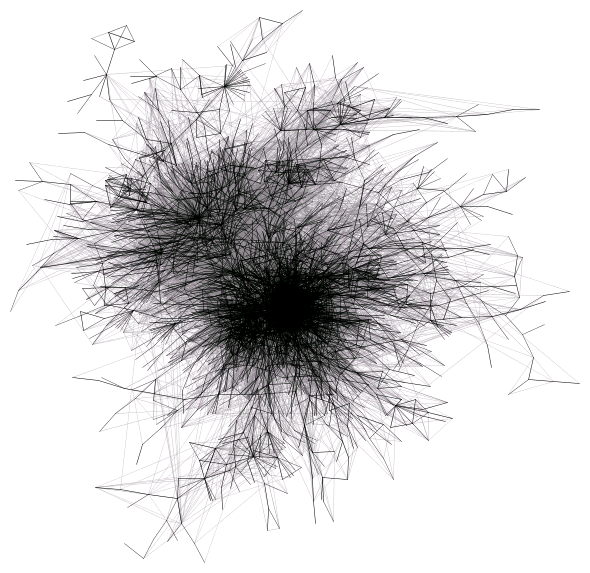
Matthew Hurst of Microsoft’s Live Labs (and apparently co-creator of BlogPulse) has a smart blog, Data Mining. See for example, his post on The Future of News which has some useful “thought starters”. (Confession: I’m a Google News junkie.) See also his Mapping The Blogosphere from which I took the image above.
Facebook: Lexicon
Brad, a student who has been working on some cool text analysis stuff, pointed me to Facebook | Lexicon. In Lexicon you type in one or more words and it will graph their popularity over time in Facebook walls. I entered “theatre, games, literature, movies” – guess which two were far more popular?
VersionBeta3 < Main < WikiTADA
We have a new version of the Big See collocation centroid. Version Beta 3 now has a graphical user interface where you can control settings before running the animation and once the animation is run. As before we show the process of developing the 3D model as an animation. Once run you can manipulate the 3D model. If you turn on stereo you can see the text model as a 3D object if you have the right glasses on (it supports different types including red/green.)
I’m still trying to articulate the goals of the project. Like any humanities computing project the problem and solutions are emerging as we develop and debate. I now think of it as an attempt to develop a visual model of a text that can be scaled out to very high resolution displays, 3D displays, and high performance computing. The visual models we have in the humanities are primitive – the scrolling page and the distribution graph. TextArc introduced a model, the weighted centroid, that is rich and rewards exploration. I’m trying to extend that into three dimensions while weaving in the distribution graph. Think of the Big See is a barrel of distributions.

